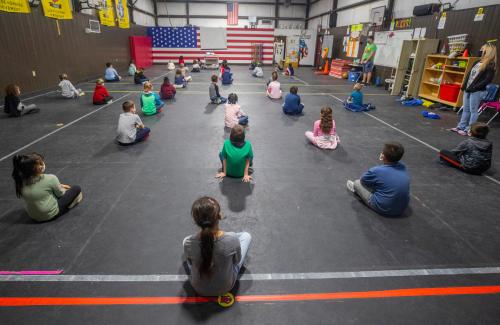The COVID-19 pandemic has led to devastating effects on our society. Over 630,000 Americans have died so far. Among those who have survived, millions fell into poverty, came close to losing their homes, and struggled to feed their families. The devastation of the pandemic and its unequal impacts have not only been felt by adults in our country. It has also been felt by our children—particularly low-income children and children of color.
At the peak of the pandemic, over 55 million American children were out of the classroom due to COVID-19-related school closures that forced districts to pivot K-12 instruction online to keep students, teachers, and staff safe. Those changes not only hindered student learning and widened pre-existing educational disparities, they also affected a broader set of outcomes for students and their families.
For instance, one consequence of school disruptions is that many families got out of their rhythm for other behaviors that are usually linked with schools—behaviors such as getting their children routine vaccinations during annual physicals and pre-participation sports physicals. The Centers for Disease Control and Prevention (CDC) has illustrated this in several published reports. They show over 60% declines in the doses of tetanus toxoid, diphtheria, acellular pertussis (Tdap) boosters administered to the 9-12 and 13-17 year-old age groups over March-May 2020 compared to the previous two years. Measles, mumps, and rubella (MMR) doses administered to children aged 2-8 years also declined by 63%, and human papilloma virus (HPV) doses among adolescents declined over 60% during March-May 2020 compared to doses administered during the same period in 2018 and 2019.
The declines in routine vaccinations in spring 2020 are not particularly surprising given the uncertainties and stay-at-home orders during that time. However, they are concerning because, even after stay-at-home orders were lifted, vaccinations did not increase to a level necessary for children and adolescents to catch up on the vaccinations they missed. These statistics suggest that children are not only vulnerable to COVID-19 variants, but many may also be more susceptible to other vaccine-preventable illnesses and outbreaks due to forgone preventive health care during the pandemic.
Part of the reason for this is linked to the structural barriers that have hindered COVID-19 vaccination efforts and resulted in all too familiar disparities in vaccination rates. For instance, according to data from the Kaiser Family Foundation’s COVID-19 Vaccine Monitor, nearly half (49%) of Hispanic parents of unvaccinated adolescents are concerned they might need to take time off work to get their child vaccinated or care for them if they experience side effects; only about a quarter of white parents (24%) share that concern.
To prevent exacerbating inequities, it is critical that schools recognize how these structural barriers may impact their students and families as they set policies to protect their community from COVID-19. When the pandemic started, we knew much less than we do now about how to protect children, families, teachers, and staff from contracting COVID-19 in school. We also knew less about who is most impacted by COVID-19 in our communities.
We now know that there are lower rates of in-school transmission when schools take proper prevention measures, such as masking, physical distancing, ensuring accessible testing, and appropriate ventilation. We also know that not every child, family, or community has the same risk of severe illness if exposed to COVID-19. Children with medical complexity are at increased risk for severe illness from COVID-19, which includes youth with special health-care needs. Nationally, children of color have also borne a disproportionate burden of death and the severe complication of Multisystem Inflammatory Syndrome (MIS-C). Data from Minnesota has shown that, although they make up only 29% of all Minnesota children 16 and under, those that live in High Social Vulnerability Index (SVI) zip codes have experienced >40% of hospitalizations due to COVID-19 since the start of the pandemic.
We cannot forget these facts as we make policies to reopen our schools, nor can we put politics ahead of public health when making reopening policies, as we have seen in some parts of the country. Rates of COVID-19 cases are increasing among children at an alarming pace, driven by the Delta variant. Employing public-health measures that have been shown to work in school settings—and doing so with an equity lens, before another surge hits—is critical for all of our children, families, teachers, and staff. Given that the majority of children in school are ineligible for COVID-19 vaccines at the start of this school year and that we know which children have (and continue to bear) the most risk due to persistent structural underinvestment, school districts’ policies should incorporate this data and evidence if they aim to live up to a commitment to health and racial equity in their COVID-19 response.
Recommendations for safer school reopenings
To protect children as schools reopen, there are at least four things education policymakers can do:
- Collaborate with local health authorities to establish a mechanism for dynamically assessing the community health risks that can affect students, teachers, and staff in schools. Monitor the local COVID-19 vaccination and infection rates in the community; find out what share of the student body is behind on routine immunizations; find out whether there have been disproportionate impacts of COVID-19 on the students and staff that make up the educational community. This information will guide steps two and three.
- Implement the CDC recommendations for schools that are feasible. In addition to requiring masks to mitigate the spread of infection throughout schools, schools can also partner with health authorities to set up regular COVID-19 testing in order to quickly identify cases when they emerge and implement quarantine procedures to minimize the spread of infection. And, when people come for their tests, it can be another opportunity to help them sign up for vaccination if they have yet to receive the shot. It will be critical for all of these procedures to be explained clearly and to be available in the multiple languages spoken by families who are in the district to ensure that parents and guardians are fully informed.
- Facilitate vaccination opportunities at school when possible. As we mentioned earlier, structural barriers are one of the big reasons that many people—and particularly people from marginalized backgrounds—remain unvaccinated. Schools can help to remove some of these barriers by working with health authorities to offer COVID-19 vaccination for all eligible students, staff, parents, and community members. They can also partner with health authorities to find creative ways to host vaccine clinics for other vaccines, too—especially the routine immunizations students might be behind on. Schools are not only venues for students to get their education, they are also places where people gather to build community and grow together. Those events, whether they be sports or the performing arts, can be opportunities to build immunity in your local community.
- Keep some remote options available. Although we understand the need to reopen schools for many students and families, we have to remember that there are many students, teachers, and staff members who are immunocompromised or otherwise medically vulnerable, making in-person attendance a high risk for their health and well-being. Schools cannot forget about those people, or relegate them to a second-class status that gets an inferior educational experience. Over the past year, we have learned a lot about remote instruction. Schools should do their best to provide high-quality instruction to those who are not able to be in person. That is part of educating equitably.
Recent months have shown us yet again how interwoven our social systems are, and how those broader systems affect the functioning of our broader society and the people within it. Schools are not just places for education; they are integral parts of the social infrastructure that supports our health and well-being. Our hope is that school districts acknowledge this and put both health and education equity at the center of their decision-making priorities in the next phase of our pandemic response. Over the past year, we have learned a lot about how our systems help or hurt different groups of people depending on who they were designed for (and who they weren’t designed for). Let us not forget that lesson like we did in the past. Instead, let us apply the knowledge we have gained during the pandemic and use it to build a safer, more equitable system of education and opportunity.









Commentary
How schools can protect our children and their future when reopening
August 26, 2021